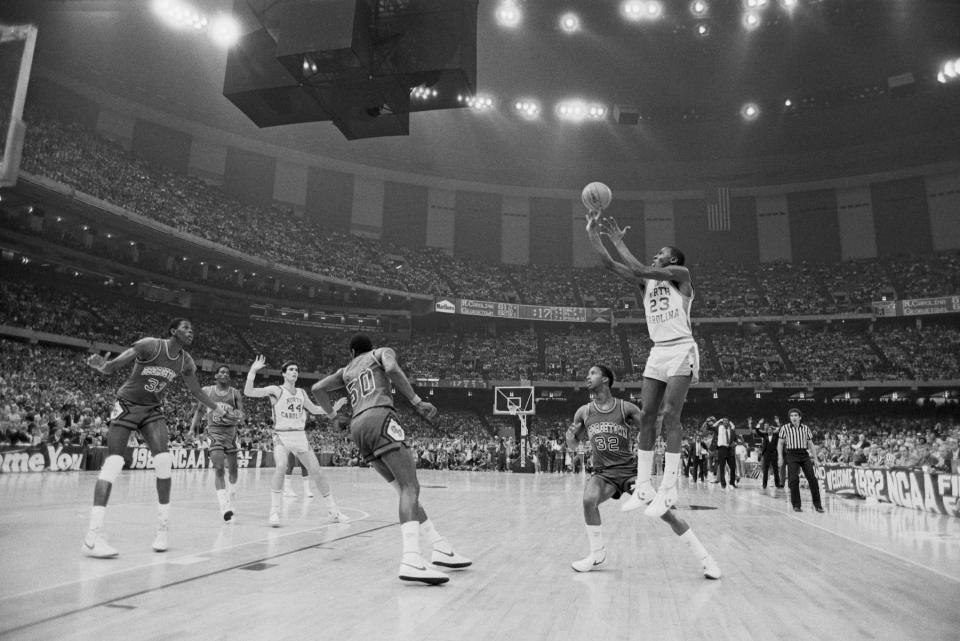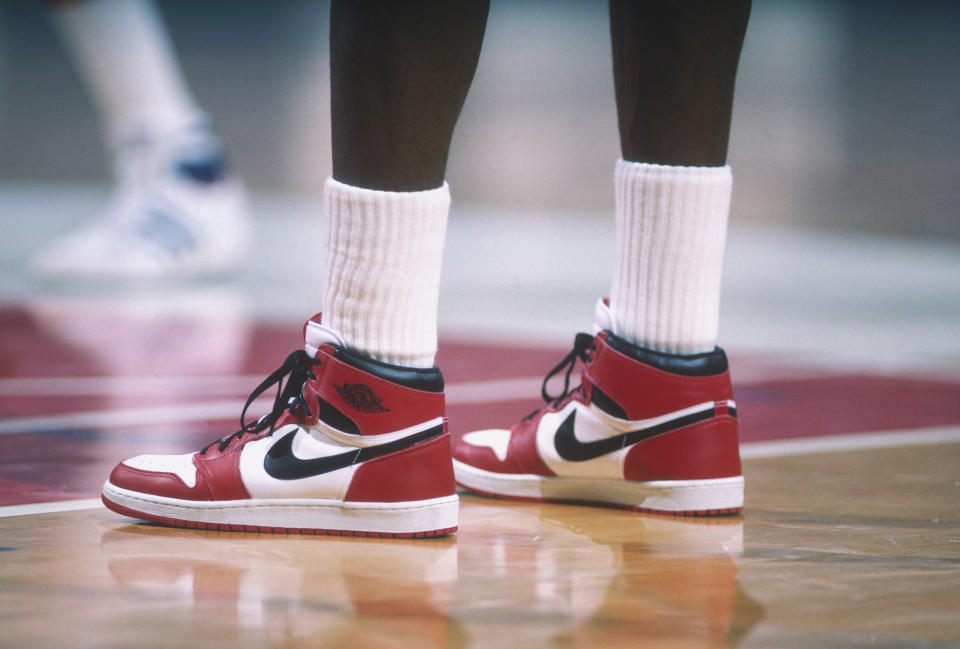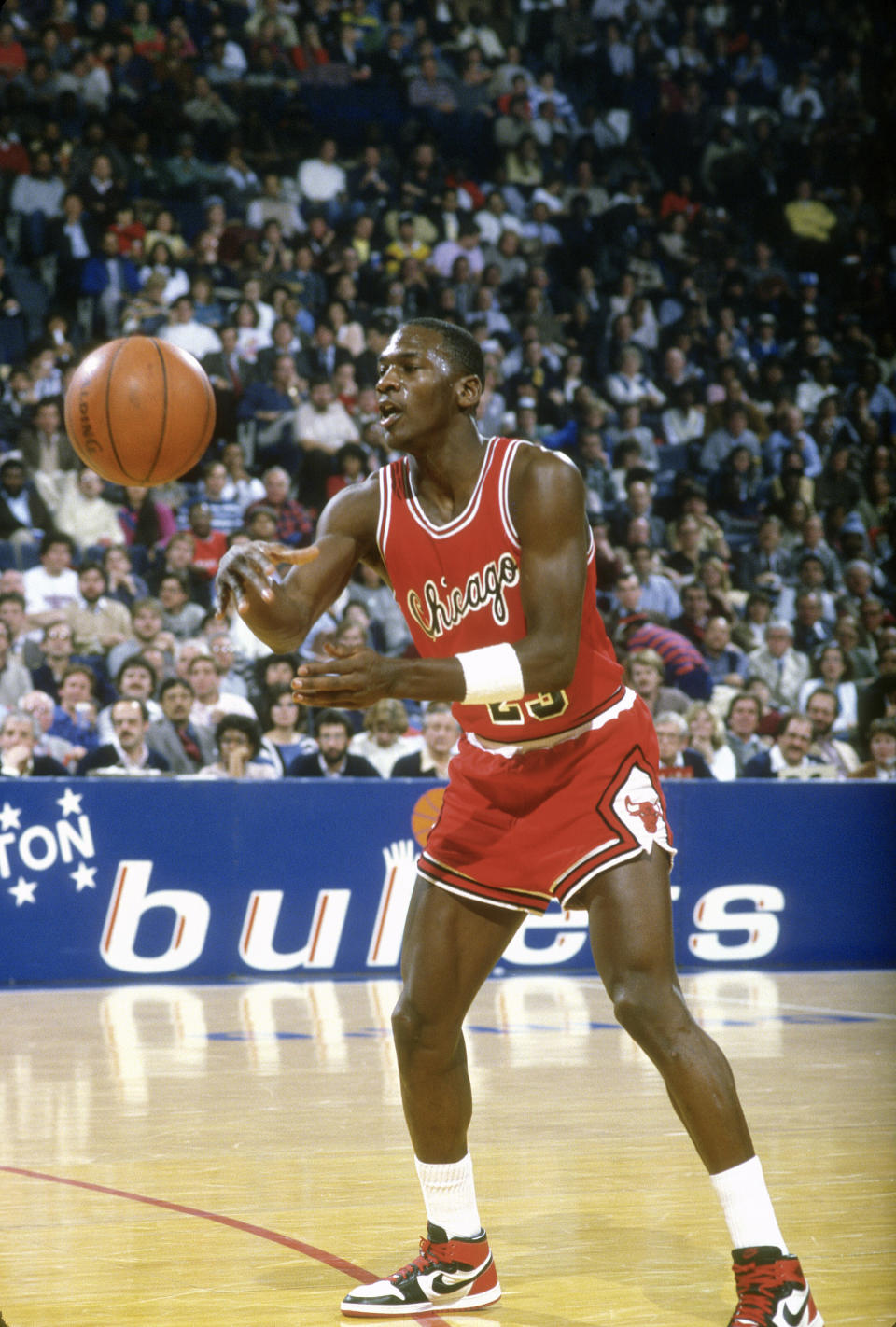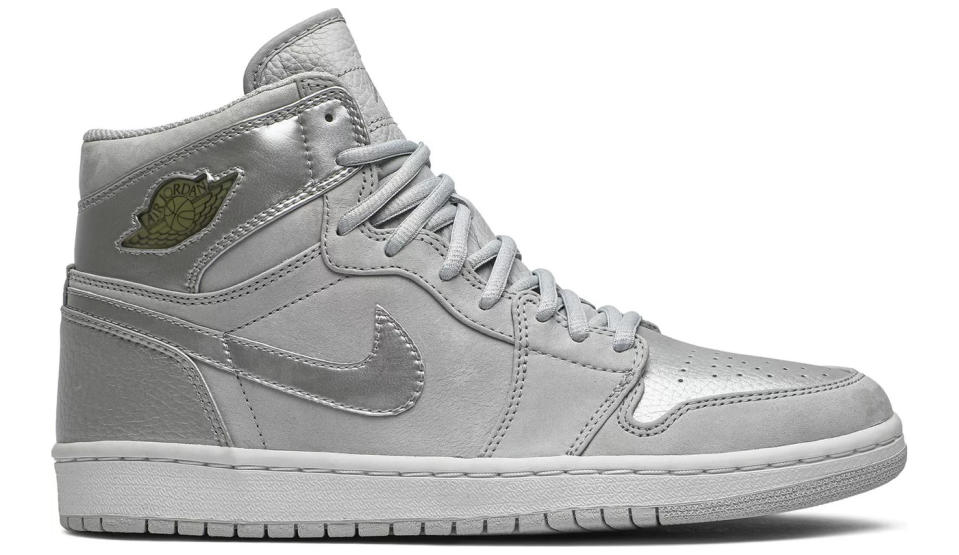Air Jordan 1 History & Timeline: Everything You Need to Know About the Air Jordan 1

Nearly 40 years ago, a 21-year-old NBA rookie would take the first steps to help reshape a company now worth more than $150 billion and create an entire culture centered upon sneakers.
On Nov. 17, 1984, Michael Jordan took to the court for the first time wearing his Nike Air Jordan 1 sneakers. It was just his 11th game as professional, and he’d already defied convention by not only getting a shoe to call his own, but a contract that surpassed even the most long-established of stars still in the NBA. Bestowing such honors to such a young player, no matter how dazzling and gravity-defying, marked a huge risk for Nike, which was still a relatively small player in the sportswear industry.
More from Footwear News
By the time Jordan’s Rookie of the Year season concluded, his shoe had already generated millions of dollars in sales for Nike while cementing a star power that would only continue to grow. Purchasing a pair of Air Jordan 1s marked the first opportunity to “Be Like Mike,” a desire that’s endured to this day to help turn Nike into one of the most valuable brands in the world and turn sneakers from practical, purpose-driven footwear into collectibles that are treated like art not only for their cultural value, but for being potential investments as well.
With more than 1,000 different versions of the sneaker having released to date, not to mention many more successors, spin-offs, and other tangible items out there among its effects, it’s far from hyperbole to say that the Air Jordan 1 is the most iconic sneaker ever made. Here, Footwear News takes a look at the history of the Air Jordan 1 and how it became such an influential item.

Before Nike
Prior to the NBA, Michael Jordan had played in Converse sneakers throughout his college and international career. The famous Chevron logo can be seen on his feet in photographs of his game-winning shot from the 1982 NCAA Championship Game as a freshman. That shoe was the Converse Pro Leather, and Jordan was also known to wear the All-Star while playing for the University of North Carolina. One of the 25 most expensive sneakers ever sold is a pair of the Converse Fastbreak Mid worn by Jordan in the 1984 Olympic Gold Medal Game, which fetched $190,000 at auction in 2017.
Despite his experience wearing Converse, Adidas was still the front runner for Jordan’s signature after he became a professional. In a clip from “The Last Dance” documentary, Jordan can be seen in his college dorm room saying, “I like the Lakers, I like Marcus Johnson, and I like Adidas shoes.”
As David Falk, Jordan’s agent from 1984 to 2003, went on to explain in the documentary, Adidas was “dysfunctional” at the time and, as much as it wanted the young star, wouldn’t have been able to give him his own shoe. Converse, which counted Magic Johnson and Larry Bird among its roster, said it wouldn’t prop up Jordan above its existing NBA stars — leaving room for Nike to swoop in despite then being an underdog in the sneaker landscape.
First Contract
Jordan’s first contract with Nike was for 5 years and $2.5 million, which was already three times greater than deals any other NBA player had ever signed. A clause in the contract would have allowed Nike to end the deal early should Jordan fail to be named Rookie of the Year, score 20 points per game, or be named an All-Star within his first three years. He’d hit all three marks in that first year, with sales to match his phenomenal rookie output.
Crucially, as depicted in the movie “Air,” Jordan’s mother Gloria insisted that her son also receive a share of the profits from his shoes. The expectation was to sell a total of $3 million worth of sneakers by the end of Jordan’s fourth year. In the first year alone, Nike would sell $126 million.
Nike Air Ship, aka the “Pre-Jordan”
Because the Air Jordan 1 wasn’t yet ready, Jordan began his NBA career playing in the Nike Air Ship. The sneaker, which was designed by Bruce Kilgore, would play a key role in the early mythos of Air Jordans because its black and red colorway drew the ire of the NBA for failing to conform to its uniform guidelines. It was actually the Air Ship, and not the Air Jordan, that was banned by the NBA and made subject to a fine every time Jordan wore it — but that wouldn’t stop Nike from running with the story when it came time to market Jordan’s first sneaker.
The Air Ship has historically been little more than a trivia answer for scrupulous sneakerheads, but the sneaker was brought back in 2023 and officially adopted as part of Jordan Brand for multiple releases, including collaborations with A Ma Maniére and Corporate.

Air Jordan 1 Debuts
The first time Jordan wore his own sneaker during an NBA game was in his 11th game, a Nov. 17, 1984 matchup at home against the Philadelphia 76ers. Its white, red, and, black “Chicago” colorway did indeed conform to the NBA uniform regulations and was the version Jordan wore most on the court. The only other colorway Jordan would wear in-game was the “Black Toe,” which features a different arrangement of the same colors. Meanwhile, the “Bred,” short for “black and red,” colorway taking after the banned Air Ship was only worn by Jordan on an NBA court during his appearance in the 1985 Slam Dunk Contest at All-Star Weekend.
Nike began selling the Air Jordan 1 in April of ‘85, beginning with six test markets in New York, Los Angeles, Chicago, Philadelphia, Detroit, and Raleigh-Durham, N.C. Selling for $65 per pair, the Air Jordans generated more than $29 million in sales in less than a month in those markets alone. It wasn’t until July that the rest of the country would gain access, and yet the phenomenon was already well under way.
Peter Moore designed the Air Jordan 1, which shares much of the same DNA as the Air Ship. Although the Jumpman logo originates from a campaign image for the Air Jordan 1, which itself was a recreation of a shot from Life magazine in which Jordan was wearing New Balance sneakers, the famous mark wouldn’t appear on a shoe until the Air Jordan 3. The signature logo for the Air Jordan 1, as well as the Air Jordan 2, is the Wings mark, which Moore first drew while sitting on an airplane having been inspired by the plastic wings captains often give to children.
The Air Jordan 1’s panels are more distinct from one another than of those on the Air Ship, which is why it’s lent itself so well to so many different color schemes over the years. Moore saw color as an important feature from the jump, as he wanted to break from the tradition of predominantly white or black sneakers that defined the sport previously. Despite the fact that red, black, and white matched the colors of his Chicago Bulls, Jordan was still initially turned off by the original “Bred” color scheme because he associated it with the devil.
Jordan would continue wearing his debut sneaker for his second NBA season, although he’d miss 64 games because of a broken foot. Upon returning from injury, he’d play in several different versions of the Air Jordan 1, including custom ankle straps and sole units borrowed from the Nike Dunk and Air Jordan 2. Some of those “Frankenstein”-esque pairs worn in-game by Jordan are also among the most expensive sneakers ever sold.

Original (or “OG”) Colorways
The Air Jordan 1s original run featured the most colorways of any sneaker in the line to date and also included low-top variants. Below is each colorway released in 1985 and 1986.
Air Jordan 1 High
“Bred” or “Banned”
“Chicago”
“Black Toe”
“Royal”
“Shadow”
“White/Grey”
“Kentucky” or “Storm Blue”
“Panda”
“UNC”
“Metallic Blue”
“Metallic Red”
“Metallic Green”
“Metallic Orange”
“Metallic Purple”
“Metallic Black”
Air Jordan 1 Low
“Metallic Blue”
“White/Grey”

First Retros
Nike reissued, or “retro-ed,” the Air Jordan 1 for the first time in 1994 for its 10-year anniversary. The “Bred” and “Chicago” colorways returned with a new price tag of $80 but would hit discount racks for a fraction of that because demand was so low. Skateboarders scooped up cheap pairs and realized the decade-old basketball tech still lent itself well to skating, creating an unexpected legacy in the sport that endures to this day.
The landscape was more receptive to classic sneakers in 2001, thanks in large part to the proliferation of “throwback” jerseys from Mitchell & Ness, the next time an Air Jordan 1 Retro released. Both the “Bred” and “Royal” colorways were reissued, while Japan also got a few new and exclusive colorways under the CO.JP banner. Even though the demand was now there, Jordan Brand would limit the number of Air Jordan 1 releases for both new and original colorways. The proliferation of variants we’re accustomed to today wouldn’t begin in earnest for another decade, and now many sneakerheads would argue that the Air Jordan 1 should return to being released on a more limited basis.
About the Author:
Ian Servantes is a Senior Trending News Editor for Footwear News specializing in sneaker coverage. He’s previously reported on streetwear and sneakers at Input and Highsnobiety after beginning his career on the pop culture beat. He subscribes to the idea that “ball is life” and doesn’t fuss over his kicks getting dirty.
Best of Footwear News
Sign up for FN's Newsletter. For the latest news, follow us on Facebook, Twitter, and Instagram.
